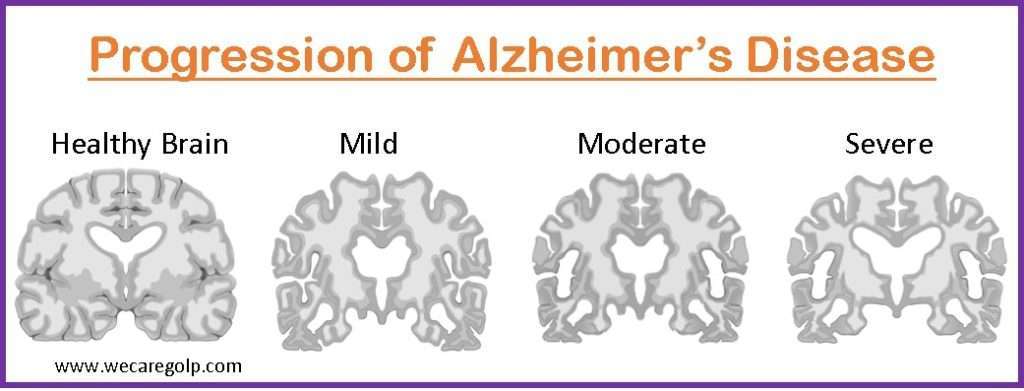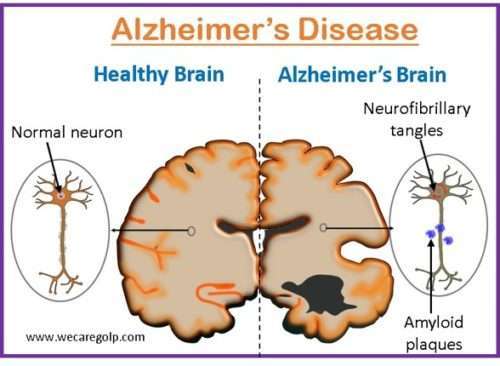Introduction
Alzheimer’s disease (AD) is a neurodegenerative disease that is progressive and occurs due to the death of nerve cells in the brain. It is the most common form of dementia caused by protein build-up in the brain affecting the transmission of messages in the brain cells. In general, Alzheimer’s disease affects parts of the brain that control:
- Memory
- Thinking
- Behavior
The disease is named after Dr. Alois Alzheimer in 1906 who noticed significant brain tissue changes in a woman who died due to an unusual mental illness. He found a lot of amyloid plaques (abnormal clumps) and neurofibrillary tangles (tangled bundles of fibers) in the brain cells that were examined only after the death of the woman.
Incidence
- According to the World Health Organization (WHO, 2022), dementia has become the seventh leading cause of death worldwide.
- Currently, more than 55 million people have dementia worldwide and there are nearly 10 million new cases every year.
- Alzheimer’s disease is the most prevalent form of dementia and may account for 60–70% of cases.
Types of Alzheimer’s Disease
Early-onset Alzheimer’s
- This type is seen in people younger than age 65 most commonly during their 40s or 50s.
- About 5% of all persons with Alzheimer’s have early onset. People affected with Down syndrome pose a higher risk for it.
- With early-onset Alzheimer’s people tend to have more brain changes that are the development of plaques and tangles as well as loss of brain volume.
- It is also linked with DNA chromosome 14 and Down’s syndrome. Muscle twitching and spasm (myoclonus) is also more common.
Late-onset Alzheimer’s
- This is the most common type of disease seen in people ages 65 and older.
- It may be hereditary but the exact cause is unknown.
Familial Alzheimer’s
- This type has certain is linked to genes.
- In the affected families, members of at least two generations have had the disease.
- Less than 1% of all cases of Alzheimer’s fall into this type.
- Most people who have early-onset Alzheimer’s have Familial Alzheimer’s disease.
Risk Factors of Alzheimer’s Disease
Alzheimer’s disease is not yet completely understood. However, there are certainly not a few factors that can influence every individual differently.
- Age
- It is the biggest risk factor for the development of Alzheimer’s disease.
- Approximately it affects one in 14 people among people over 65 years of age and one in six people over 80 years of age.
- Smoking
- Obesity, high cholesterol levels
- Diabetes
- High blood pressure
- Untreated depression, loneliness, and social isolation
- Inactive lifestyle
- Hearing loss
- History of severe head injury
- Learning disability (Down’s syndrome)
- Genetic (very rare) etc.
Signs and Symptoms according to Stages

Early stages (Mild)
The symptoms are often very mild. Memory loss is the most noticeable symptom. The person may:
- Forget recent conversations or events, appointments, names of people, objects, places, etc.
- Misplace items
- Struggle to find the appropriate words
- Repeat themselves
- Other symptoms may be:
- Mood changes
- Feeling discomfort in unfamiliar situations or changes in daily routine
- Withdrawn
- Difficulty in making decisions
Middle stages (Moderate)
- Increasing disorientation and confusion
- Getting lost in familiar places
- Delusions and hallucinations
- Repetitive/obsessive behaviors
- Speech and language difficulties
- Disturbed sleep
- Difficulty with spatial awareness (visualizing objects from different perspectives or 3D format) and impaired judgment
Late stages (Severe)
New symptoms may develop like
- Aggressive behavior
- Difficulty eating and swallowing
- Incontinence of urine and stool
- Loss of speech
- Problems with mobility
- Increasingly becomes weak/frail
- Weight loss
Pathophysiology of Alzheimer’s Disease
- The brain has 100 billion neurons which connect to form communication networks.
- Groups of nerve cells are involved in different functions like communication, thinking, learning, and memory as well as vision, hearing, and smell.
- Neurons receive nutrition supplies, generate energy, and get rid of waste.
- Keeping everything well-functioning requires great coordination and large amounts of fuel and oxygen.
- Microscopic changes in the brain begin many years before the appearance of the first signs of memory loss.
- Plaque and tangles are the two abnormal structures that play a major role in the destruction and death of nerve cells.
- Beta-amyloid is the plaques thatare deposits of a protein fragment that builds up in the spaces between the nerve cells.
- Twisted fibers or tangles of another protein called “tau” builds up inside the cells.
- The damage and death of nerve cells cause memory loss, changes in personality, and other symptoms related to Alzheimer’s disease.
Diagnosis of Alzheimer’s Disease
Physical and neurological examinations
- Reflexes
- Muscle tone and strength
- Sense of sight and hearing
- Muscle coordination and balance
Mental status examination
- A detailed examination is done to assess memory and other thinking skills compared with people of the same age and education level.
Blood tests
- To rule out other potential causes of memory loss and confusion some blood tests can be done.
- Thyroid disorder
- Vitamin levels
- Beta-amyloid protein
- Tau protein
Brain imaging
It is done to rule out visible changes related to conditions other than Alzheimer’s disease that may cause similar symptoms, such as strokes, brain trauma, brain tumors, and Parkinson’s disease.
- Magnetic resonance imaging (MRI) may show shrinkage of some brain regions associated with Alzheimer’s disease and also rule out other conditions. An MRI is generally preferred to a CT scan to evaluate dementia of Alzheimer’s type.
- Computerized tomography (CT) is usually done to rule out tumors, strokes, and head injuries.
- Positron emission tomography (PET) can capture images of the disease process that may include:
- Fluorodeoxyglucose (FDG) PET imaging scans show areas of the brain in which nutrients are poorly metabolized. Low metabolism patterns can help differentiate between Alzheimer’s disease and other forms of dementia.Amyloid PET imaging measures the burden of amyloid deposits in the brain and is used if a person has an unusual or very early onset of symptoms.
- Tau PET imaging measures the tangles in the brain.
Lumbar puncture
- A collection of cerebrospinal fluid (CSF) via lumbar puncture (spinal tap) to measure amyloid and tau in the CSF is done if symptoms are quickly worsening or if the disease is seen at a very early age which is uncommon.
Treatment/Management of Alzheimer’s Disease
Medications
Although there is no cure for Alzheimer’s disease some medications can help manage the symptoms.
- The following drugs can help improve cognition but do not reverse or slow down the disease process in the brain
- Cholinesterase inhibitors (e.g., donepezil and rivastigmine) and
- N-methyl-D-aspartate (NMDA) receptor antagonist (memantine)
- People who have mood changes, such as depression or irritability can be managed with
- Antidepressants medicines
- Antipsychotic medicines
- Antianxiety medicines.
Safe and supportive environment
An important part of the treatment plan is to adapt to the needs of Establishing and strengthening routine habits and cutting down on tasks that require memory to adapt to the needs of a person with Alzheimer’s disease. These are different ways to support a person’s sense of well-being and continued ability to function:
- Keep valuables, keys, wallets, mobile phones, etc. in the same place
- Keep medicines in a secure cabinet.
- Arrange finances by activating automatic payments and deposits.
- Have the person carry a cell phone with features of location tracking and a medical alert bracelet.
- Install sensors with alarms on doors and windows.
- Take regular appointments on the same day and at the same time as possible.
- Use a calendar, reminders, or whiteboard to follow daily routines.
- Remove excess furniture, and messy rugs, and fit handrails on stairs and bathrooms.
- Make sure that slippers and shoes are comfortable and non-slippery.
- People with AD may perceive images in mirrors as scary or confusing so remove excess mirrors.
Lifestyle changes
A healthy lifestyle promotes brain health as well as overall good health.
- Regular exercise and daily walking help in mood stabilization and maintain healthy muscles, joints, lungs, and the heart. It also promotes sound sleep and prevents constipation. People who have trouble walking may use a stationary bike, or elastic bands for stretching or perform chair exercises, etc.
- Nutrition is important to people with Alzheimer’s as they may forget to eat and drink, lose interest in food, or may not have healthy foods. Thus healthy/favorite food, adequate fluids, high-calorie protein shakes and smoothies, and avoidance of caffeine are encouraged.
- Social activities can help to preserve skills and abilities as well as overall well-being. Activities that are enjoyable and meaningful like listening to music or dancing, reading or listening to audiobooks, gardening or crafting, attending social events at senior care centers, and activities with children are helpful.
- Because people with AD experience a variety of emotions, including confusion, frustration, uncertainty, anger, fear, grief, depression, and others, they require support and coping mechanisms. Reassure the person that life can be enjoyed by providing support, listening to them, and helping to retain dignity and self-respect. New situations, noise, large groups of people, being forced to remember, or being asked to do complex tasks can cause anxiety thus a calm and stable home environment can help reduce behavior problems.
Complications of Alzheimer’s Disease
People living with Alzheimer’s disease can have many complications related to advanced age, impaired cognition, memory, etc. such as:
- Pneumonia related to improved oral hygiene, aspirations advanced age, etc
- Bedsores related to impaired mobility
- Falls due to motor and cognitive impairment.
- Urinary tract infection and other infections related to incontinence and poor hygiene
- Malnutrition and dehydration due to decreased appetite, difficulty in eating, etc.
- Dental problems related to poor hygiene
- Behavior problems
Prevention of Alzheimer’s Disease
Although there is no known cause for Alzheimer’s disease, adopting a healthy lifestyle can help lower the risk.
- Avoid smoking and alcohol
- Eating a healthy and balanced diet
- Aerobic exercise (moderate-intensity) for at least 150 minutes per week
- Stay mentally and socially active
- Blood pressure control
- Reduce the risk of diabetes
Prognosis
- People with Alzheimer’s disease can have a normal life span after the development of symptoms but this can vary among individuals.
- As the disease is a progressive neurological problem, it can cause difficulties in swallowing that may cause aspiration leading to frequent chest infections.
- People with Alzheimer’s disease have difficulty eating and decreased appetite.
- Thus, people with AD need palliative care as well as support for families and caregivers.
Summary
- Alzheimer’s is a chronic neurodegenerative disease that progresses over many years.
- It usually begins after 65 years 65.
- Most people with Alzheimer’s disease present with forgetfulness.
- It has been shown that plaques and neurofibrillary tangles build up in the brain.
- Although the main cause of AD is unknown diabetes, obesity, high cholesterol, smoking, depression, and limited social contacts are some of the risk factors for the disease.
- AD is not a treatable condition some medications like cholinesterase inhibitors and N-methyl-D-aspartate receptor antagonists can help improve cognition.
- A healthy lifestyle, supportive environment, familiar surroundings, etc. can help improve the patient’s quality of life.
References
- Lane, C. A., Hardy, J., Schott, J.M., (2017, Sep 4). Alzheimer’s disease. European journal of neurology, 25(1)59-70. https://doi.org/10.1111/ene.13439
- WebMD (2021, Feb 03). Understanding Alzheimer’s Disease: the Basics. Retrieved on 2023, Apr 2 from https://www.webmd.com/alzheimers/guide/understanding-alzheimers-disease-basics
- Alzheimer’s Association (n. d.) What is Alzheimers?. Retrieved on 2023, Apr 1 from https://www.alz.org/alzheimers-dementia/what-is-alzheimers
- World Health organization (n.d.). Dementia. Retrieved on 2023, Apr 1 from https://www.who.int/news-room/fact-sheets/detail/dementia

